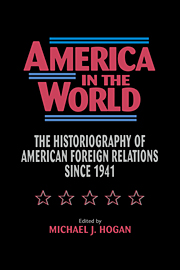Book contents
- Frontmatter
- Contents
- Preface
- The Authors
- Part One The State of the Art
- Part Two The Historiography of American Foreign Relations since 1941
- 6 The Historiography of American Foreign Relations: An Introduction
- 7 A Half-Century of Conflict: Interpretations of U.S. World War II Diplomacy
- 8 The Decision to Use the Bomb: A Historiographical Update
- 9 Origins of the Cold War in Europe and the Near East: Recent Historiography and the National Security Imperative
- 10 Making Known the Unknown War: Policy Analysis of the Korean Conflict since the Early 1980s
- 11 Eisenhower Revisionism: The Scholarly Debate
- 12 John F. Kennedy as World Leader: A Perspective on the Literature
- 13 The Unending Debate: Historians and the Vietnam War
- 14 Complaints, Self-Justifications, and Analysis: The Historiography of American Foreign Relations since 1969
- 15 An Emerging Synthesis? U.S.–Latin American Relations since the Second World War
- 16 Gideon's Band: America and the Middle East since 1945
- 17 The Cold War in Asia: The Elusive Synthesis
- 18 The Power of Money: The Historiography of American Economic Diplomacy
- 19 Coming in from the Cold War: The Historiography of American Intelligence, 1945–1990
- Index
18 - The Power of Money: The Historiography of American Economic Diplomacy
Published online by Cambridge University Press: 05 June 2012
- Frontmatter
- Contents
- Preface
- The Authors
- Part One The State of the Art
- Part Two The Historiography of American Foreign Relations since 1941
- 6 The Historiography of American Foreign Relations: An Introduction
- 7 A Half-Century of Conflict: Interpretations of U.S. World War II Diplomacy
- 8 The Decision to Use the Bomb: A Historiographical Update
- 9 Origins of the Cold War in Europe and the Near East: Recent Historiography and the National Security Imperative
- 10 Making Known the Unknown War: Policy Analysis of the Korean Conflict since the Early 1980s
- 11 Eisenhower Revisionism: The Scholarly Debate
- 12 John F. Kennedy as World Leader: A Perspective on the Literature
- 13 The Unending Debate: Historians and the Vietnam War
- 14 Complaints, Self-Justifications, and Analysis: The Historiography of American Foreign Relations since 1969
- 15 An Emerging Synthesis? U.S.–Latin American Relations since the Second World War
- 16 Gideon's Band: America and the Middle East since 1945
- 17 The Cold War in Asia: The Elusive Synthesis
- 18 The Power of Money: The Historiography of American Economic Diplomacy
- 19 Coming in from the Cold War: The Historiography of American Intelligence, 1945–1990
- Index
Summary
Books concentrating on economic diplomacy rarely find an audience. Even professional historians, whose business it is to read weighty tomes, often retreat when confronted with a book with the word “economic” in the title or if they see financial facts figuring heavily in the notes. Yet one of the most influential books of the last fifteen years was a work that profoundly affected the way we think about economic diplomacy in general and American economic diplomacy in particular. Even more astoundingly, the book not only became a basic university text but a must-buy for nonspecialist readers and a crucial part of the 1988 presidential election campaign.
The book in question is The Rise and Fall of the Great Powers by Paul Kennedy. It represented first of all a return to history on the grand scale. In his book, Kennedy analyzed the trajectory of every imperial state since the end of the Renaissance. He covered the seventeenth- and eighteenth-century Spanish, Dutch, British, and French systems, which ended with the British victory at Waterloo. Kennedy then incorporated an analysis of British strengths and weakness within a discussion of the struggle for mastery of the European Great Powers during the nineteenth century. His twentieth-century survey did not neglect the two world wars but focused on the Cold War superpowers, the United States and the Soviet Union. Kennedy ended his book by projecting the future path of the main powers that existed fifteen years before the end of the twentieth century: the Soviet Union, the European Economic Community, Japan, China, and the United States.
- Type
- Chapter
- Information
- America in the WorldThe Historiography of US Foreign Relations since 1941, pp. 536 - 561Publisher: Cambridge University PressPrint publication year: 1996
- 1
- Cited by



